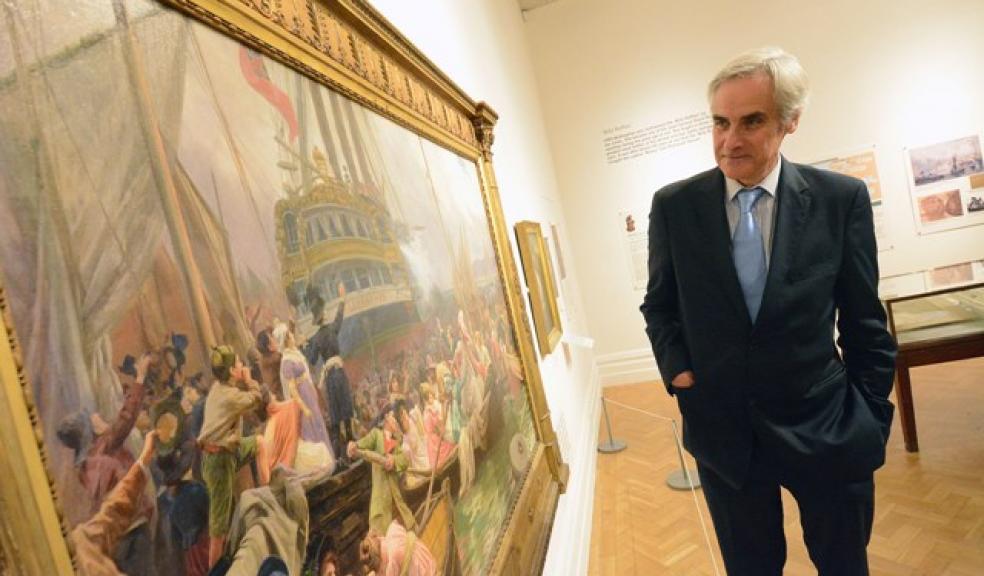
Bonaparte returns....
It’s not often Plymouth gets a visit from a Bonaparte – the last time hundreds of people rowed out to a ship in the Sound to look at the fallen emperor.
But this time Charles Bonaparte, who is chair of the European Federation of Napoleonic Cities, came in peace and came face-to-face with a famous image of his ancestor at an event in the Plymouth City Museum.
Monsieur Bonaparte, a direct descendent of Napoleon Bonaparte, was invited to the exhibition at the City Museum and Art Gallery about the dramatic visit of Napoleon Bonaparte in 1815.
The exhibition is centered round the popular painting by Jules Girardet ‘Fallen Emperor: Napoleon in Plymouth Sound in 1815’ which shows Napoleon standing on the deck of HMS Bellerophon while hundreds of local people in rowing boats flock to catch a glimpse of him.
Deputy Council Leader Peter Smith said: “We are delighted to have Monsieur Bonaparte to hear his thoughts on the federation and look forward to exploring this idea. It’s fantastic to see him here in Plymouth.
“This exhibition relates to an extraordinary episode in Plymouth’s history when the French Emperor, a long-time enemy of Britain, was actually here – defeated at the Battle of Waterloo and a prisoner on board HMS Bellerophon.
“Because 200 years have lapsed, people don’t necessarily realise how much the Napoleonic Wars shaped the city of Plymouth – or the ‘Three Towns’ of Plymouth, Stonehouse and Devonport, as they were then known.
“The wars helped cement the city’s strategic military and naval importance and work began on the Breakwater during this era, Dock – the dockyard town expanded massively. Whatever way you look at it Napoleon had a huge impact on Plymouth.”
Chief Executive of Destination Plymouth, Amanda Lumley, added: “It’s been a real privilege to have one of the descendants of Napoleon here in Plymouth to see this exhibition about a unique moment in Plymouth’s history. It provides a real sense of pride as Napoleon’s campaign across Europe in the 1800s helped shape the city Plymouth is today.
“The visit and exhibition has also given us a real flavour of what the Federation of Napoleonic Cities is all about. We look forward to considering the detail of what being in the Federation may offer and how it will benefit the city, both here and internationally.”
Other facts about Napoleonic Plymouth:
• As a Naval port and defended garrison Plymouth experienced and witnessed to true cost of over 20 years of war with France.
• The Dockyard expanded still further during the Napoleonic Wars
• Warships were built in the Dockyard and a private shipyard in Turnchapel.
• The Military Hospital, now Devonport high School for Boys, was built in 1797.
• Plymouth’s Cattewater and Sutton Harbour became a major centre for receiving and selling captured ‘prize’ ships and their cargoes.
• Dartmoor Prison was built for French and American POWs
• Thousands of troops poured into and around the Three Towns. Some camped at Maker and Roborough, many embarking here on military campaigns.
• Thousands of troops left from Plymouth to fight in the Peninsular War. Many returned to Plymouth wounded or diseased after defeat at the Battle of Corunna
• After Waterloo, there were some 8,000 POWs in Millbay prison, at Dartmoor ‘Depot’ and on hulks on the River Tamar – which were captured on canvas by Turner
• The war saw periods of civic unrest with food shortages and low wages, fuelled by poor harvests and rising prices. This led to occasional but serious riots.
• In 1797, there was a Naval mutiny in Plymouth aboard HMS Powerful and, in a separate incident, three marines were executed on the Hoe for treason.
• In 1805, Plymothians were among the very first to hear and the first to publish news of Nelson’s death in victory at Trafalgar
• Injured sailors were taken up Stonehouse Creek to the military hospital at Stonehouse – this is allegedly where the expression ‘up the creek without a paddle’ comes from
• Napoleon’s brother Lucien came to Plymouth as a POW in 1810. He had fallen out with Napoleon, so was greeted well! He came ashore at Lambhay, with his family, servants and 33-tons of baggage, lodging at Plymouth’s ‘Kings Arms’
The theme for this year’s Lord Mayor’s Day on Saturday 6 June will also be Napoleon and HMS Bellerophon.
Exhibition opening hours will be 10am to 5.30pm Tuesday to Friday and 10am to 5pm on Saturdays. Admission is free.












